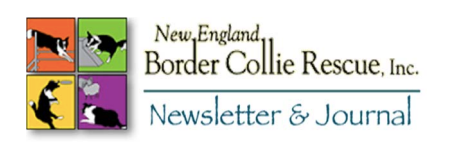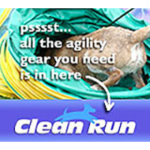Newsletter & Journal 2.3
VOLUME II NUMBER 3
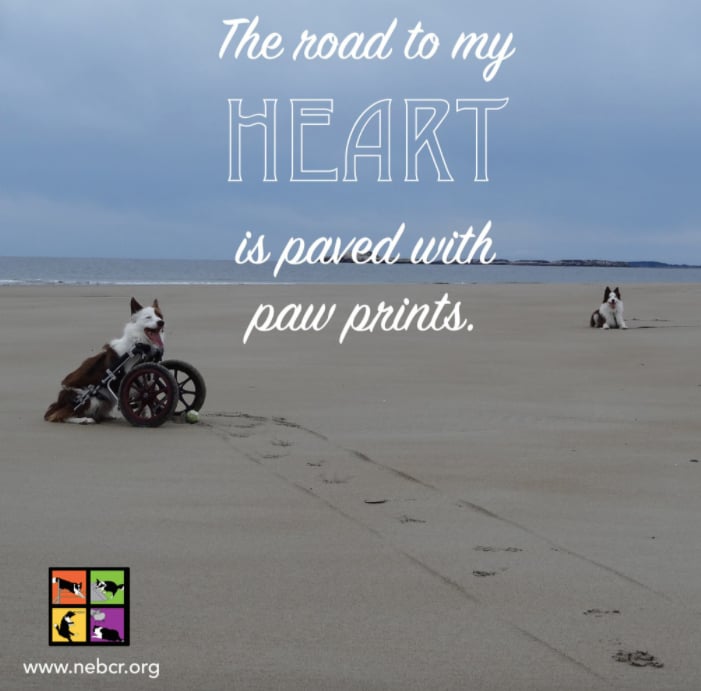
Co-Presidents: Bea Hamm & Sarah Hepburn
Treasurer: Mo Clark
Secretary: Emily Wu
Board of Directors: Monique Fisher, Elise Gouge, Marie Hinds
Website: Rebeca Kerr & Monique Fisher
Editors: Bea Hamm & Rebeca Kerr
Please send your content and pictures to us at: nebcrnewsletter@gmail.com
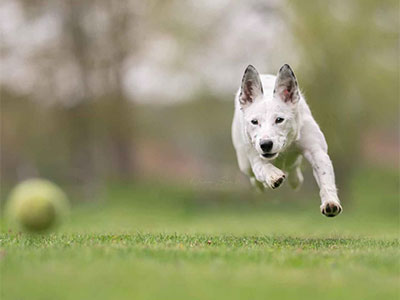
Featured: Violet
Yes she is a BC mix, yes she is high energy but she is also a great sports prospect and had a great start in an experienced foster home. Violet LOVES to train and has been a star at her age appropriate agility training. Violet has a lot to offer in a small package at 30lbs.
You’ll find her full bio here.
TRAINER’S CORNER:
Fireworks: Be Prepared
by Elise Gouge, CPDT, CABC Certified Behavior Consultant & Trainer
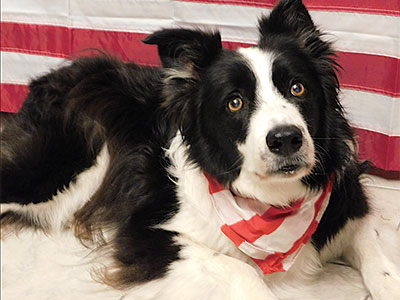
I remember being a kid and getting so excited about the 4th of July! Running around with sparklers, shooting off fireworks in the backyard, watching the town’s big displays, and just enjoying that wonderful festive summer joy!
Then I got border collies.
While I won’t say that all border collies are sound-sensitive or afraid of fireworks – I will say that border collies are sensitive in general and not the same as other breeds. Our beloved border collies are genetically engineered to notice every nuance in the environment so that they can keep their flock where it needs to be. For most of us, we don’t have active farm dogs, so our border collies are channeling their sensitivity into whatever urban or suburban home they are in. Often, they are sensitive to fireworks, thunder and even other random sounds like blenders, vacuums and oven beepers. Not only are they sensitive to those sounds but they also are professionals with backchaining – where they are able to predict that an event is likely to happen based on the things happening before it. My NEBCR dog, Leelah Bean, had a blender aversion and so when I opened a specific drawer in the kitchen, she began stressing out because she had backchained that opening the drawer meant getting out a piece of kitchenware which meant the blender would be turned on.
Sound sensitivity is not always a tender, soft kind of sensitivity. It can manifest as running in circles, barking loudly, trying to escape, panicking, biting whatever gets in their way, and other intense behaviors. Of course, it can also include the more commonly known symptoms like shaking, refusing to eat, being inconsolable, laying in a bathtub or crawling under the bed or into a closet, whining and just overall misery.
Plus, remember how I mentioned backchaining? Well, some dogs backchain annually and will start stressing over events when they sense they are coming up. For example, the weather is warming up, grills are being lit and the air smells different and suddenly your border collie knows the fireworks must be right around the corner so it’s time to stress out.
Helping your dog cope with general sound sensitivity and specific firework fear is important and literally save their life. Here are some steps to keep in mind.
First, watch your dog and see if you notice changes in their behavior and, if so, what’s the antecedent? What’s happening right before the change? Log it if you have to since that can help identify patterns.
Next, once you identify the triggers, try to put a plan in place to help your dog get through the tough times. Set up a safe space where sounds are minimized, call your vet about a situations medication to temporarily alleviate anxiety, take advantage of the various over the counter options like melatonin, l-theanine and colostrum. Use ambient sound like box fans on high, televisions or radios turned on and sound machines. A great article by Eileen Anderson discussed the importance of sound masking versus sound elimination. The link for that article is here: https://eileenanddogs.com/blog/2013/12/30/sound-sensitive-reactive-dogs/. They sell ear muffs for dogs and lots of other cool gear to help dogs with sound issues.
The biggest and most important tip I can give you is to prepare ahead of time. Nothing will work very well if you’re trying it on the Fourth of July. Set up that safe space in April, begin acclimating your dog to ear muffs in January, you get the idea. Every year I get panicked calls from owners and when you’re that far in it, all you can do is some damage control by minimizing exposure and possibly using medication if your vet thinks it’s a good idea. The key is to prepare ahead of time. One concrete way to practice relaxing ahead of time is to work on Dr. Karen Overall’s updated Relaxation Protocol. You can find links for audio and video on Youtube if you type the name into the search bar.
Although I’m focusing on sound issues, I would be remiss if I didn’t mention making sure to keep your dog safe around grills and summer cookouts. Dogs grabbing bones from trash or straight from the grill can pose a huge safety risk and there’s also the potential for resource guarding from dogs and people.
Make sure your dog and any visiting dogs get along and leave lightweight drag lines on them so you can easily get the dog if needed. Have those safe spaces set up to give dogs breaks. Better to have it and not need it than the other way around!
Stuff some Kongs and freezer them or have some high value chews on hand to help distract and occupy your dog.
Lastly, there’s a common myth that it’s wrong to comfort your dog if they are stressed. It is entirely appropriate and ok to comfort your dog! Providing reassurance, calm support and gentle soothing can all help. Don’t stress up with your dog or get intensely emotional, if you can help it. However, it can be hugely helpful to be available to your dog to support them and decrease their anxiety and stress.
In summary, plan ahead, talk to your vet, identify and avoid situations that are too much for your dog, and utilize the supports available like ambient noise makers, ear muffs and more. Surviving the holidays in good form will help each year go smoothly so everyone can enjoy the excitement and joy that comes with summertime!
Knowing Peace
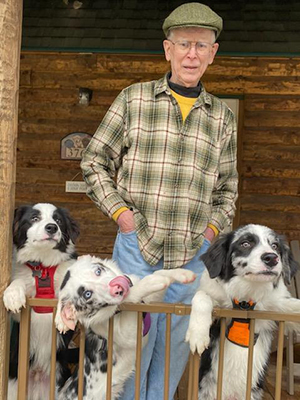
No one knows what tomorrow will bring. A few months ago NEBCR was contacted by a family in a very difficult situation. Their beloved uncle was terminally ill and no longer able to care for his two young Border Collies. The family stepped in to care for the dogs as they searched for a solution. When contacted NEBCR jumped into the process of gathering information, setting up an evaluation and ultimately finding foster homes for these two boys.
The uncle, Douglas Kinney though facing the end of his life himself made every effort that the two boys, Hank and Fred would be well cared for and have the easiest transition possible. He provided NEBCR with as much information as possible on their history, medical, personalities and needs to help find them a forever home where the boys and new family would both be happy. They came into rescue with their crates, beds, toys and food making the transition as smooth as possible.
We are grateful that both dogs found their new families before fate stepped in to take Douglas from this world and onto the next. He passed knowing Hank and Fred had become a cherished member of their new families off on new adventures. NEBCR was notified of his passing with a heartfelt email from his family. Here is a quote “Our Uncle shared that there are no words to express his gratitude to NEBCR, the amazing folks on the frontlines with the pups, and the amazing people behind the scenes. Please know he had peace knowing they were safe and loved”.
Though a very sad situation NEBCR is thankful to be able to step in to put the family at ease concerning the boys future. In the process two new families feel truly blessed to now have Hank and Fred in their lives.
Highland Games
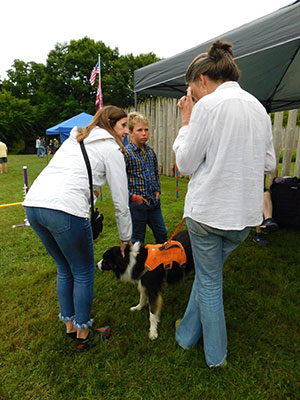
On June 29th NEBCR attended an event in Charlestown, NH. The event was the first Highland Games held at the Fort at #4. The weather could have been better with on and off rain most of the day but it didn’t seem to dampen anyone’s spirits, there was a great turnout. It was an immense opportunity to educate, make connections and take in $900+ for the day. Our volunteers stayed busy the entire day and were impressed with the children that interacted with our dogs, very respectful. One young boy in particular, a budding dog trainer returned to the booth 3 times!
I’m very proud of our demo dogs that for the most part took an entire day of commotion and what must have looked like total chaos to them in stride. Lots of greetings, demos, bag pipes, drums, a band and even a cannon going off, they barely skipped a beat.
Upcoming:
July 26th bidding opens on the NEBCR’s Summer Fundraising Auction. If you want to show your support for NEBCR and get a little something in in process you can join the fun. Barb is busy still posting items from artwork to training gear. To get a preview and get setup for bidding click here.
August 10th NEBCR Reunion at Sugar Bush Farm, Stephentown, NY. This has been a long tradition to unite volunteers and previous adopters. We hope to have a good turnout this year. Not open to the general public.
August 17th Highland Games Thomas Point Beach, Maine. I would guess we have been doing this event for a decade now; always an opportunity to educate while doing demos with the dogs. We have a booth setup right next to the sheep herding demo! Now that keeps our pups entertained for the day.
So, You Think You Want a Border Collie?
by Kerry Maloney
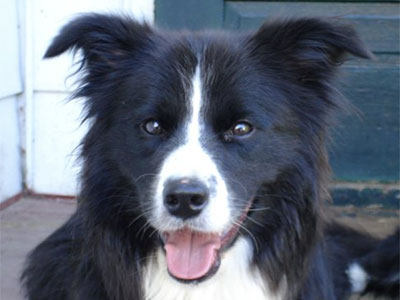
I’ve been lucky enough to have had numerous border collies in my life – from my first border collie, Dublin, to my current border collie, Belle, and the countless other personal and foster dogs who have shared their lives with me over the years. They all have had their quirks, but all have had the brilliant brain of a border collie. Some were a bit more blessed with brains than others, but all had moments of genius.
My current border collie, Belle, is freakishly smart. She will learn the name of a new toy in only one to two tosses of it. She has over 90 toys she knows the individual names of and will go find the specific toy I ask for without fail. She has an incredible vocabulary and understands what I want her to do almost intuitively. She is amazing but sometimes her smarts can get her into a spot of bother.
One morning, while I was in the bathroom getting ready to go out and run some errands, Belle decided to engage her big brain to solve a problem. She had dropped her beloved toy (a stuffed slice of pizza) down between the head of my bed and my bedside table. She’s done this before but this time it had apparently bounced and wedged itself between the box spring and the headboard.
Now, the thing I regret most teaching Belle is “figure it out”. So…she did. She figured she needed to dig all the covers out of the way, and this was apparently accomplished without any problems. Then she needed to dig all the pillows out of the way, which mostly went without problems…until she got to the feather-filled body pillow that I kept up against my headboard to prevent my other pillows from slipping down between the headboard and the mattress….
I first became aware of the disaster that awaited me when I left the bathroom to go back to my bedroom and saw a completely feather-covered Belle standing in the hallway, waiting for me. Belle gave me her rather impatient “Human, I need your assistance!” bark and turned back toward my room while I just gaped at the waft of feathers trailing after her….
I walked back into my bedroom to see her jump up onto the bed (can you picture the additional “flooomph” of feathers that poofed off the bed from this?), bark at me once more and proceeded to start DIGGING AT THE FEATHER PILLOW AGAIN in case I was too stupid to figure out the seriousness of the issue of the trapped pizza.
Words…words cannot begin to express the amount of feathers that were just…everywhere…I mean…EVERYWHERE….I had no idea a single pillow could contain the feathers of three million geese. The horror of it was beyond description…. I stopped Belle from digging (but sadly was unable to get her to stay still for more than .0003 seconds so the feathers kept going everywhere). I proceeded to gather up the remains of my poor innocent pillow and its guts. I put it in a garbage bag and tried to vacuum up what I could. My vacuum basically said, “I don’t get paid enough for this” and quit on me and I didn’t blame it. It took me forever to round up all the feathers and to this day I will still find an occasional feather that I missed.
Oh, and because I know I’ll get asked….yes, I got the stupid toy unstuck and back to Belle.
ASK THE VET: Hot Spots/Summer Itch
by Dr Sarah Hepburn
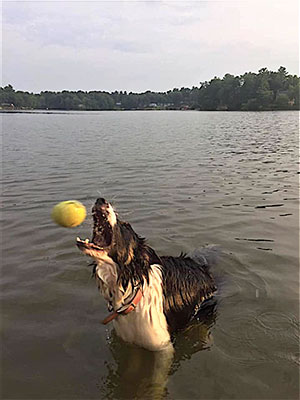
Summer days mean hikes, swimming and lounging at the water. However, summer heat also brings increased risk of illness and injury to your dog.
Water Intoxication
Water intoxication, also known as water poisoning or hyperhydration, occurs when pets ingest excessive amounts of water. This condition can result from activities like swimming, playing with water hoses, or even drinking large quantities of water in a short period.
When a pet consumes too much water, it dilutes the sodium levels in their bloodstream. Sodium is essential for maintaining proper cellular function, and its imbalance can cause cells to swell. This swelling is particularly dangerous in the brain, leading to increased pressure in the skull and on the brain.
Symptoms of water intoxication include lethargy, vomiting, bloating, loss of coordination, excessive salivation, and seizures. In severe cases, it can lead to coma or death. Immediate veterinary attention is crucial. Treatment typically involves intravenous administration of electrolytes to restore sodium balance and reduce intracranial pressure.
Heat Stroke
Heat stroke is another critical condition, especially prevalent during the hot summer months. Pets, particularly dogs, are prone to overheating as they lack efficient sweat glands and primarily cool themselves through panting. When exposed to high temperatures and humidity, their bodies can quickly overheat.
Early signs of heat stroke include excessive panting, drooling, reddened gums, and increased heart rate. As it progresses, symptoms can escalate to vomiting, diarrhea, mental confusion, uncoordinated movements, and collapse. Body temperatures above 104°F (40°C) are indicative of heat stroke.
Immediate action is vital. Move the pet to a cooler environment, and apply cool (not cold) water to their body, focusing on the head, neck, and underbelly. Offer small amounts of cool water to drink. Seek veterinary care immediately, as untreated heat stroke can lead to organ failure and death.
Burnt Pads on Hot Pavement
Another common but preventable issue in the summer is burnt paw pads from hot pavement. Asphalt and concrete can reach extremely high temperatures, capable of causing severe burns to your pet’s sensitive paw pads. The temperature gradient between the air and the pavement can be significant; on an 85°F (29°C) day, pavement temperatures can exceed 135°F (57°C), which is hot enough to cause burns in just a minute of contact.
Before walking your pet, check the pavement’s temperature by placing the back of your hand on it for seven seconds. If it’s too hot for your hand, it’s too hot for your pet’s paws.
Signs of burnt pads include limping, refusal to walk, licking or chewing at the feet, visible blisters, or red, damaged skin. If your pet has burnt pads, seek veterinary care immediately.
Prevention
Preventing these conditions involves vigilance and proactive care. For water intoxication, monitor your pet’s water intake during activities involving water. Limit their time playing in water and encourage regular breaks.
To prevent heat stroke, avoid outdoor activities during peak heat hours, ensure access to shade and fresh water, and never leave pets in parked cars. Recognize your pet’s limits; some breeds are more susceptible to heat due to their coat type, body structure, or age.
For paw pad safety, walk your pet during cooler parts of the day—early morning or late evening. Consider using protective booties if walks on hot surfaces are unavoidable.
Finnegan’s VNS Trial Completion
by Donna Ciarlante
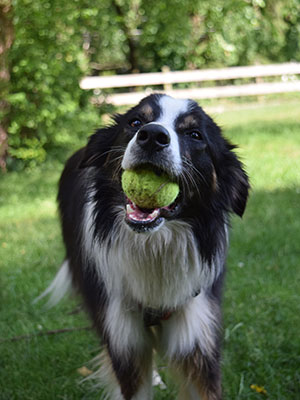
My foster dog, Finnegan, completed a year long clinical trial for a vagal nerve stimulator (VNS) in late May 2024. It was an act of fate that he was able to begin the trial as we were out of treatment options for his epilepsy. Without an effective treatment in sight, his quality of life would be poor and he would likely require further hospital admissions making his care costs unsustainable. It seems like a miracle that he actually completed the trial.
Placing the VNS was a minor surgical procedure similar to getting a pacemaker. Finnegan’s VNS was placed in April 2023. After a month of healing, the stimulator was turned on and gradually increased over the next 6 months. In typical Finnegan fashion, he recovered smoothly and quickly. He hasn’t experienced any problems or side effects. Finnegan is a favorite among his care team. Despite everything he’s been through, he remains sweet, trusting and persevering. The consensus among his caregivers is “Finnegan isn’t giving up.” I call him the luckiest unlucky dog in the world because he has a village supporting him.
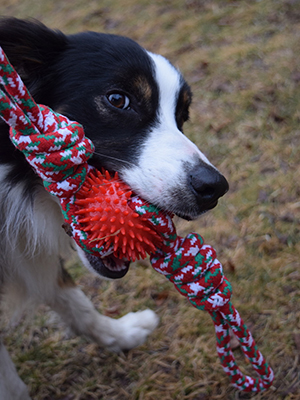
The goal of the trial was to evaluate the effectiveness of VNS for dogs diagnosed with idiopathic epilepsy who do not respond to medications. Through fostering Finnegan, I’ve learned that epilepsy is a devastating condition for families. I’ve learned of unwavering dedication despite the unpredictability, hard work and emotional turmoil that comes with loving a dog with epilepsy. And I’ve learned of the unbearable grief of having to prematurely say goodbye because there is nothing left to offer. It is frustrating and difficult to accept that we
have so few options for these otherwise healthy dogs.
For this reason, I am thankful that Finnegan and I participated in this trial. There is no cure for epilepsy at this time We desperately need more treatment options, especially ones that have minimal side effects. Frustrated by the lack of treatments, researchers worldwide are stepping up recently with a variety of studies. Besides the VNS trial, other encouraging studies underway include diet, the microbiome, and precision medications that target specific brain molecules.
Progress is slow but hopeful.
The results for the five participants of the VNS trial will determine if a larger study should be pursued. I do not know yet how the other four dogs in the study have done. As for Finnegan, he has not had a cluster seizure event in more than 18 months and therefore has not required any hospitalizations. While he continues to have seizures more frequently than we would like, the seizures have been single and mild. His “cluster buster” cocktail, which had stopped being effective, is working again. His quality of life has improved with a slight decrease in medication.
From human experiences, the VNS can become more effective with time. I hope this will be true for Finnegan. He’ll continue to live his best life possible while time reveals the effectiveness of this treatment. I am grateful to Tuft’s University Foster Hospital Neurology for their efforts toward finding treatments for dogs with epilepsy and for providing this opportunity to Finnegan at no cost to NEBCR. I wish them tremendous success in helping our beloved border collies and all dogs with epilepsy.
